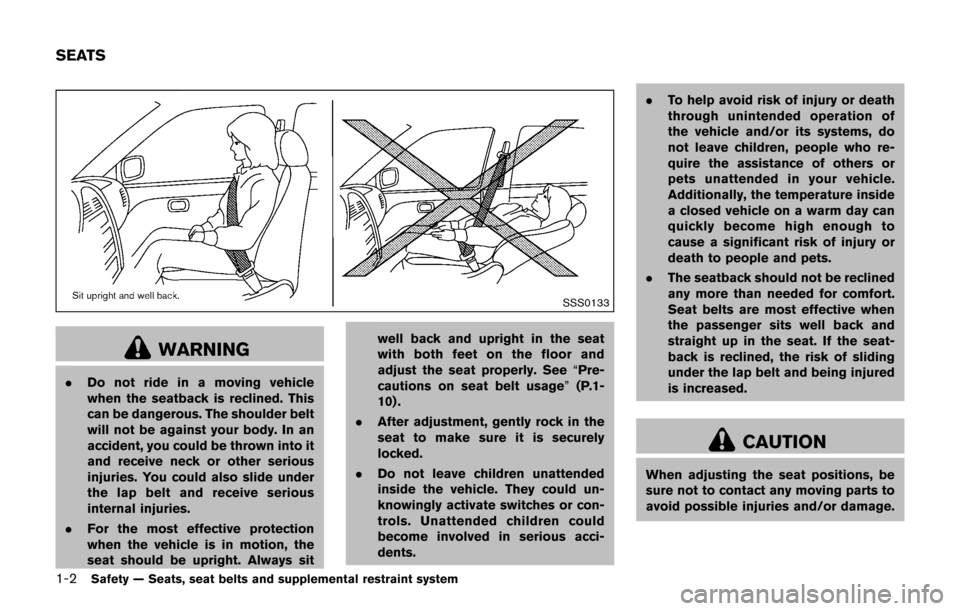Page 12 of 416
JVC0977X
1. Hood (P.3-15)
2. Windshield wiper and washer— Switch operation (P.2-36)
— Blade replacement (P.8-15)
— Window washer fluid (P.8-9) 3. Parking lights, turn signal lights and front side
marker lights
— Switch operation (P.2-39)
— Bulb replacement (P.8-26)
4. Moonroof* (P.2-52)
5. Power windows (P.2-50)
6. Outside mirrors (P.3-22) 7. Side turn signal lights
— Switch operation (P.2-43)
— Bulb replacement (P.8-26)
8. Front view camera* (P.4-13)
9. License plate installation (P.10-13)
10. Fog lights* — Switch operation (P.2-44)
— Bulb replacement (P.8-26)
11. Headlights — Switch operation (P.2-39)
— Bulb replacement (P.8-23)
12. Tires — Wheels and tires (P.8-28, P.10-9)
— Flat tire (P.6-3)
— Tire Pressure Monitoring System (TPMS)
(P.2-18, P.5-3)
13. Side view camera* (P.4-13)
14. Doors — Keys (P.3-2)
— Door locks (P.3-4)
— Intelligent Key system (P.3-6)
— Security system (P.2-33)
*: if so equipped
Illustrated table of contents0-3
EXTERIOR FRONT
Page 13 of 416
0-4Illustrated table of contents
JVC0745X
1. Liftgate (P.3-16)— Intelligent Key system (P.3-6)
2. Rear window wiper and washer
— Switch operation (P.2-37)
— Window washer fluid (P.8-9)
3. High-mounted stop light (P.8-23) 4. Antenna (P.4-75)
— Satellite radio antenna* (P.4-35)
5. Rear window defroster (P.2-38)
6. Fuel-filler door
— Operation (P.3-18)
— Fuel information (P.10-4) 7. Rear view camera
— RearView Monitor* (P.4-8)
— Around View
�ŠMonitor* (P.4-13)
8. Rear combination lights — Bulb replacement (P.8-26)
9. Child safety rear door lock (P.3-6)
*: if so equipped
EXTERIOR REAR
Page 15 of 416
0-6Illustrated table of contents
JVC0184X
1. Cargo area— Cargo cover* (P.2-49)
— Cargo light (P.2-55, P.8-23)
2. Coat hook (P.2-48)
3. Sun visors (P.3-21)
4. Microphone (P.4-80, P.4-89)
5. Moonroof switch* (P.2-52) 6. Room light and map lights (P.2-54)
7. Inside rearview mirror (P.3-21)
8. Door armrest
— Power window switch (P.2-50)
— Power door lock switch (P.3-5)
*: if so equipped
PASSENGER COMPARTMENT
Page 21 of 416

0-12Illustrated table of contents
Warninglight Name
Page
All-Wheel Drive (AWD) warning
light (yellow) (AWD model) 2-16
Anti-lock Braking System
(ABS) warning light2-16
Brake warning light
2-16
Charge warning light2-17
Door open warning light2-17
Electric power steering warning
light2-17
Engine oil pressure warning
light2-17
High temperature warning light
(if so equipped)
2-18
Intelligent Key system warning
light2-18
Low fuel warning light
2-18
Low tire pressure warning light2-18
Low washer fluid warning light
(if so equipped)2-20
P position selecting warning
light2-20Warning
light Name
Page
Seat belt warning light 2-20
Supplemental air bag warning
light2-20
Vehicle Dynamic Control (VDC)
warning light2-21Indicator
light Name
Page
All-Wheel Drive (AWD) indica-
tor light (green) (AWD model) 2-21
All-Wheel Drive (AWD) -V indi-
cator light (green) (AWD model)
2-21
Continuously Variable Trans-
mission (CVT) indicator light (if
so equipped)2-21
Cruise indicator light
2-21
Engine start operation indicator
light2-21
Exterior light indicator
2-22
Front fog light indicator light (if
so equipped)2-22
Front passenger air bag status
light2-22
High beam indicator light
2-22
Malfunction Indicator Light
(MIL)2-22
Security indicator light
2-23
Turn signal/hazard indicator
lights2-23
Vehicle Dynamic Control (VDC)
off indicator light
2-23
WARNING AND INDICATOR LIGHTS
Page 23 of 416

1-2Safety — Seats, seat belts and supplemental restraint system
SSS0133
WARNING
.Do not ride in a moving vehicle
when the seatback is reclined. This
can be dangerous. The shoulder belt
will not be against your body. In an
accident, you could be thrown into it
and receive neck or other serious
injuries. You could also slide under
the lap belt and receive serious
internal injuries.
. For the most effective protection
when the vehicle is in motion, the
seat should be upright. Always sit well back and upright in the seat
with both feet on the floor and
adjust the seat properly. See
“Pre-
cautions on seat belt usage” (P.1-
10) .
. After adjustment, gently rock in the
seat to make sure it is securely
locked.
. Do not leave children unattended
inside the vehicle. They could un-
knowingly activate switches or con-
trols. Unattended children could
become involved in serious acci-
dents. .
To help avoid risk of injury or death
through unintended operation of
the vehicle and/or its systems, do
not leave children, people who re-
quire the assistance of others or
pets unattended in your vehicle.
Additionally, the temperature inside
a closed vehicle on a warm day can
quickly become high enough to
cause a significant risk of injury or
death to people and pets.
. The seatback should not be reclined
any more than needed for comfort.
Seat belts are most effective when
the passenger sits well back and
straight up in the seat. If the seat-
back is reclined, the risk of sliding
under the lap belt and being injured
is increased.
CAUTION
When adjusting the seat positions, be
sure not to contact any moving parts to
avoid possible injuries and/or damage.
SEATS
Page 24 of 416

SSS0792
Type A (if so equipped)
JVR0342X
Type B (if so equipped)
FRONT SEATS
Front manual seat adjustment
Forward and backward:
Pull the lever
*1up and hold it while you slide
the seat forward or backward to the desired
position. Release the lever to lock the seat in
position.
Reclining (Type A) (if so equipped):
To recline the seatback, pull the lever
*2up and
lean back. To bring the seatback forward, pull
the lever up and lean your body forward. Release
the lever to lock the seatback in position.
The reclining feature allows adjustment of the
seatback for occupants of different sizes for
added comfort and to help obtain proper seat
belt fit. (See “Precautions on seat belt usage”
(P.1-10) .) Also, the seatback can be reclined to
allow occupants to rest when the vehicle is
stopped and the transmission is in the P (Park)
position or N (Neutral) position with the parking
brake fully applied.
Reclining (Type B) (if so equipped):
To recline the seatback, turn the adjusting dial
*2toward the rear of the vehicle and lean back.
To bring the seatback forward, turn the adjusting
dial toward the front of the vehicle and lean your
body forward.
Safety — Seats, seat belts and supplemental restraint system1-3
Page 27 of 416

1-6Safety — Seats, seat belts and supplemental restraint system
JVR0051X
The illustration shows the seating positions
equipped with head restraint/headrest.
Indicates the seating position is equipped
with a head restraint.
Indicates the seating position is equipped
with a headrest.
+ Indicates the seating position is not equipped
with a head restraint or headrest.
. Your vehicle is equipped with a head
restraint/headrest that may be integrated,
adjustable or non-adjustable.
. Adjustable head restraints/headrests have
multiple notches along the stalk to lock them
in a desired adjustment position. .
The non-adjustable head restraints/head-
rests have single locking notch to secure
them to the seat frame.
. Proper Adjustment:
— For the adjustable type, align the head
restraint/headrest so the center of your
ear is approximately level with the center
of the head restraint/headrest.
— If your ear position is still higher than the recommended alignment, place the head
restraint/headrest at the highest position.
. If the head restraint/headrest has been
removed, ensure that it is reinstalled and
locked in place before riding in that desig-
nated seating position.
SSS0992
ADJUSTABLE HEAD RESTRAINT/
HEADREST COMPONENTS
1. Removable head restraint/headrest
2. Multiple notches
3. Lock knob
4. Stalks
Page 28 of 416

JVR0203X
NON-ADJUSTABLE HEAD RE-
STRAINT/HEADREST COMPONENTS
1. Removable head restraint/headrest
2. Single notch
3. Lock knob
4. Stalks
SSS1037
REMOVE
Use the following procedure to remove the head
restraint/headrest.
1. Pull the head restraint/headrest up to thehighest position.
2. Push and hold the lock knob.
3. Remove the head restraint/headrest from the seat.
4. Store the head restraint/headrest properly in a secure place so it is not loose in the
vehicle.
5. Reinstall and properly adjust the head restraint/headrest before an occupant uses
the seating position.
SSS1038
INSTALL
1. Align the head restraint/headrest stalks withthe holes in the seat. Make sure that the
head restraint/headrest is facing the correct
direction. The stalk with the adjustment
notch
*1must be installed in the hole with
the lock knob
*2.
2. Push and hold the lock knob and push the head restraint/headrest down.
3. Properly adjust the head restraint/headrest before an occupant uses the seating posi-
tion.
Safety — Seats, seat belts and supplemental restraint system1-7